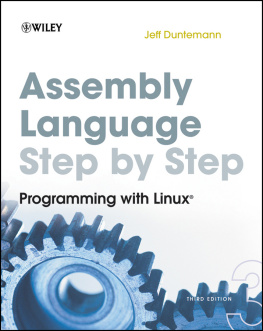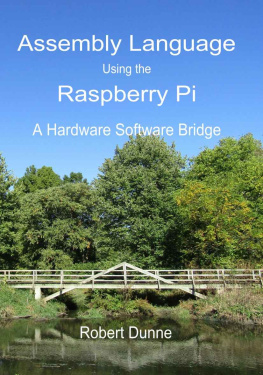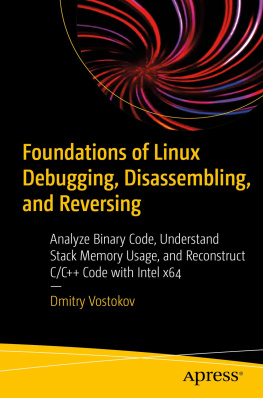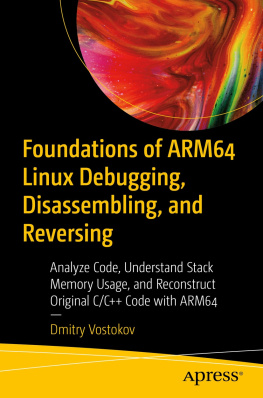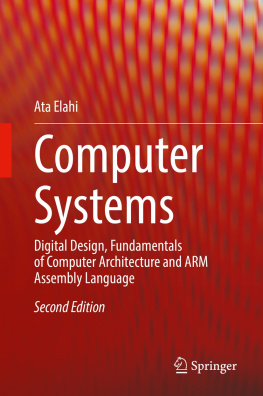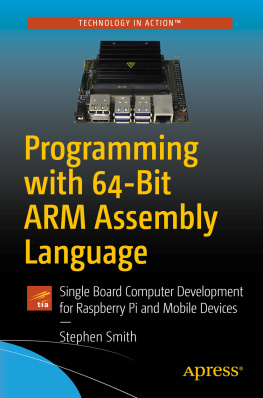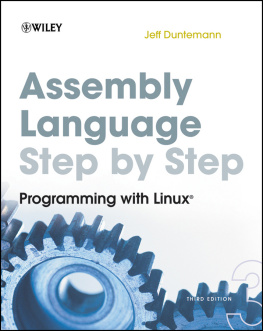Assembly Language Step-by-Step
Published by
Wiley Publishing, Inc.
10475 Crosspoint Boulevard
Indianapolis, IN 46256
www.wiley.com
Copyright 2009 by Jeff Duntemann
Published by Wiley Publishing, Inc., Indianapolis, Indiana
Published simultaneously in Canada
ISBN: 978-0-470-49702-9
No part of this publication may be reproduced, stored in a retrieval system or transmitted in any form or by any means, electronic, mechanical, photocopying, recording, scanning or otherwise, except as permitted under Sections 107 or 108 of the 1976 United States Copyright Act, without either the prior written permission of the Publisher, or authorization through payment of the appropriate per-copy fee to the Copyright Clearance Center, 222 Rosewood Drive, Danvers, MA 01923, (978) 750-8400, fax (978) 646-8600. Requests to the Publisher for permission should be addressed to the Permissions Department, John Wiley & Sons, Inc., 111 River Street, Hoboken, NJ 07030, (201) 748-6011, fax (201) 748-6008, or online at http://www.wiley.com/go/permissions.
Limit of Liability/Disclaimer of Warranty: The publisher and the author make no representations or warranties with respect to the accuracy or completeness of the contents of this work and specifically disclaim all warranties, including without limitation warranties of fitness for a particular purpose. No warranty may be created or extended by sales or promotional materials. The advice and strategies contained herein may not be suitable for every situation. This work is sold with the understanding that the publisher is not engaged in rendering legal, accounting, or other professional services. If professional assistance is required, the services of a competent professional person should be sought. Neither the publisher nor the author shall be liable for damages arising herefrom. The fact that an organization or Web site is referred to in this work as a citation and/or a potential source of further information does not mean that the author or the publisher endorses the information the organization or Web site may provide or recommendations it may make. Further, readers should be aware that Internet Web sites listed in this work may have changed or disappeared between when this work was written and when it is read.
For general information on our other products and services please contact our Customer Care Department within the United States at (877) 762-2974, outside the United States at (317) 572-3993 or fax (317) 572-4002.
Wiley also publishes its books in a variety of electronic formats. Some content that appears in print may not be available in electronic books.
Library of Congress Control Number: 2009933745
Trademarks: Wiley and the Wiley logo are trademarks or registered trademarks of John Wiley & Sons, Inc. and/or its affiliates, in the United States and other countries, and may not be used without written permission. Linux is a registered trademark of Linus Torvalds. All other trademarks are the property of their respective owners. Wiley Publishing, Inc. is not associated with any product or vendor mentioned in this book.
To the eternal memory of
Kathleen M. Duntemann, Godmother
19201999
who gave me books when all I could do was put teeth marks on them.
There are no words for how much I owe you!
About the Author
Jeff Duntemann is a writer, editor, lecturer, and publishing industry analyst. In his thirty years in the technology industry he has been a computer programmer and systems analyst for Xerox Corporation, a technical journal editor for Ziff-Davis Publications, and Editorial Director for Coriolis Group Books and later Paraglyph Press. He is currently a technical publishing consultant and also owns Copperwood Press, a POD imprint hosted on lulu.com. Jeff lives with his wife Carol in Colorado Springs, Colorado.
Credits
Executive Editor
Carol Long
Project Editor
Brian Herrmann
Production Editor
Rebecca Anderson
Copy Editor
Luann Rouff
Editorial Director
Robyn B. Siesky
Editorial Manager
Mary Beth Wakefield
Production Manager
Tim Tate
Vice President and Executive Group Publisher
Richard Swadley
Vice President and Executive Publisher
Barry Pruett
Associate Publisher
Jim Minatel
Project Coordinator, Cover
Lynsey Stanford
Proofreader
Dr. Nate Pritts, Word One
Indexer
J&J Indexing
Cover Image
Jupiter Images/Corbis/Lawrence Manning
Acknowledgments
First of all, thanks are due to Carol Long and Brian Herrmann at Wiley, for allowing this book another shot, and then making sure it happened, on a much more aggressive schedule than last time.
As for all three previous editions, I owe Michael Abrash a debt of gratitude for constant sane advice on many things, especially the arcane differences between modern Intel microarchitectures.
Although they might not realize it, Randy Hyde, Frank Kotler, Beth, and all the rest of the gang on alt.lang.asm were very helpful in several ways, not least of which was hearing and answering requests from assembly language newcomers, thus helping me decide what must be covered in a book like this and what need not.
Finally, and as always, a toast to Carol for the support and sacramental friendship that has enlivened me now for 40 years, and enabled me to take on projects like this and see them through to the end.
Introduction: Why Would You Want to Do That ?
It was 1985, and I was in a chartered bus in New York City, heading for a press reception with a bunch of other restless media egomaniacs. I was only beginning my media career (as Technical Editor for PC Tech Journal ) and my first book was still months in the future. I happened to be sitting next to an established programming writer/guru, with whom I was impressed and to whom I was babbling about one thing or another. I won't name him, as he's done a lot for the field, and may do a fair bit more if he doesn't kill himself smoking first.
But I happened to let it slip that I was a Turbo Pascal fanatic, and what I really wanted to do was learn how to write Turbo Pascal programs that made use of the brand-new Microsoft Windows user interface. He wrinkled his nose and grimaced wryly, before speaking the Infamous Question:
Why would you want to do that ?
I had never heard the question before (though I would hear it many times thereafter) and it took me aback. Why? Because, well, becauseI wanted to know how it worked .
Heh. That's what C's for.
Further discussion got me nowhere in a Pascal direction. But some probing led me to understand that you couldn't write Windows apps in Turbo Pascal. It was impossible. Orthe programming writer/guru didn't know how. Maybe both. I never learned the truth. But I did learn the meaning of the Infamous Question.
Note well: When somebody asks you, Why would you want to do that ? what it really means is this: You've asked me how to do something that is either impossible using tools that I favor or completely outside my experience, but I don't want to lose face by admitting it. Sohow bout those Blackhawks?
I heard it again and again over the years:
Q: How can I set up a C string so that I can read its length without scanning it?
A: Why would you want to do that?
Q: How can I write an assembly language subroutine callable from Turbo Pascal?
A: Why would you want to do that?
Q: How can I write Windows apps in assembly language?
A: Why would you want to do that?
You get the idea. The answer to the Infamous Question is always the same, and if the weasels ever ask it of you, snap back as quickly as possible, Because I want to know how it works.

